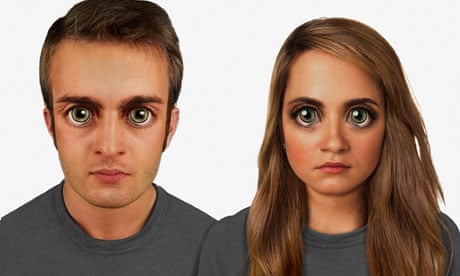Since we humans are prone to launching chemical weapons, unwittingly killing off the bee population or other factors that could lead to our extinction, it may be presumptuous to imagine what we'll look like in 100,000 years. But designer and researcher Nickolay Lamm has speculated anyway, concluding with some rather startling illustrations that suggest that we'll look a bit like the aliens in Close Encounters of the Third Kind: large, bug eyes, huge foreheads and pigmented skin.
It's conjecture, but also more than armchair futurism. Lamm based his illustrations on discussions with Dr Alan Kwan, an expert in computational genomics from Washington University who drew up a research paper to guide Lamm's artwork.
Kwan broke down his predictions into what the human face would look like in 20,000 years, 60,000 years and 100,000 years, and they are predicated on two fundamental developments: our living environment will have changed drastically; and people will have more control over human biology and evolution, thanks to advancements in genetic engineering.
Changes in the air and light around us will lead to adjustments in our facial structure, but we'll also be able to change what facial features we're born with, based on what's genetically trendy at the time. Kwan believes that, 60,000 years from now, the evolution of our faces will essentially be moot, thanks to our ability to control the human genome.
According to Kwan and Lamm's conclusions, one of the most obvious evolutionary changes by then will be a larger head, a part of our bodies which, according to scientists, has been growing since the Middle Ages. It will keep swelling in the coming millennia to accommodate ever-expanding brains.
Our eyes will grow to Japanese anime-style proportions in the meantime, as human beings are forced to live in other colonies of the solar system and in dimmer environments farther away from the sun. As more people live outside the Earth's protective ozone layer, they'll also come into contact with increased UV radiation, and our skin – more obviously among Caucasians – will become more pigmented.
Once humans have gained "total mastery over morphological genetics", post-60,000 years from now, we'll be tweaking our children's DNA so that they're born with straight noses, regal lines and perfect facial symmetry.
Lamm says he hopes his artwork will inspire people to "create their own visions of what the future holds for our species". Much of his previous artwork has a "what if" quality to it, and tends to go viral, including his illustrations of submerged cities in a future world of rising sea levels. He is currently speaking to multiple experts and using 3D-models to illustrate what the human body might look like in 100,000 years.
Parmy Olson is a technology writer for Forbes magazine in San Francisco. She is the author of 'We Are Anonymous' (Little Brown, 2012).




Comments (…)
Sign in or create your Guardian account to join the discussion